
Hydraulic Imagery in Medieval Arabic Texts

The Arabic reports about irrigation, dams and water-powered machines form a cultural construction which could be called hydraulic imagery. The term imagery is related to the perception patterns concerning hydraulic constructions inasmuch these patterns are reproduced in documental genres in the specific geographical, historical and cultural context of the sources. Thus the references on water-power range from reports about milling output in terms of day-production of meal or flour up to impressive accounts about marvellous machines with the features of a perpetuum mobile. These references are embedded in various textual sources which belong to a quite heterogeneous spectre of literary genres including geographical and cosmographical works (like those of al-Dimashq), technological treatises (like the compendia of ingenious devices presented by Bana Musa and al-Jazari) as well as administration documents. Undoubtedly such reports are inspired by the historical reality of hydraulic constructions scattered from al-Andalus and the Maghreb in the Muslim West to Mesopotamia and Transoxania in the East. However, the specific reporting forms as well as several features attributed textually to the constructions under discussion reflect narrative conventions of the specific literary genre rather than realistic representation modes of technological artefacts. The present study develops a typology of such patterns and proposes interpretation models for their emerging on the basis of the specific socio-economic context and the features of the dominant literary traditions in which the narrative patterns concerning the hydraulic imagery are encountered. ...
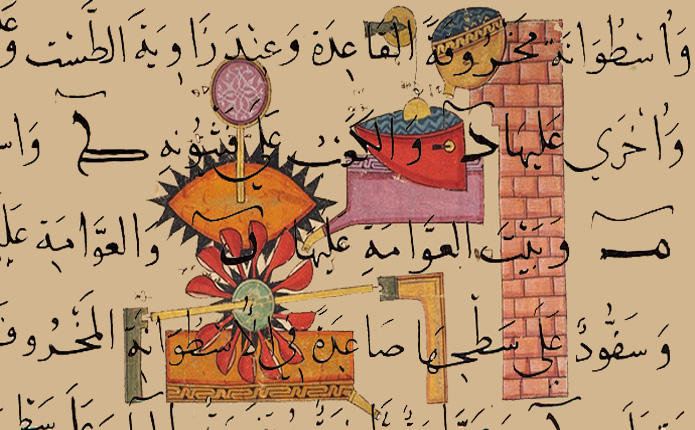
Article Banner (Source)
Hydraulic engineering in the medieval Arab world: the historical background
The use of water-power for operating machines has a long tradition in the several regions which came under the dominion of Islam in the medieval times. This heritage includes scientific traditions in the Greco-Roman world, as well as the numerous aspects and technological features of water-powered machines all over the Mediterranean, as well as the Near East and the Middle East.
The expansion of the Muslim state in the Mediterranean, the Mesopota-mia and the Iranian territory during the 7th century AD enabled contacts and interactions of several scientific and engineering cultures under the Muslim rule. In the case of water-powered machines and hydraulic technology in general different geomorphological landscapes and climatic conditions acted as a polymorphic background for know-how transfer and further development. Novel techniques for crop irrigation were substantial for the transfer of species like cotton, sugar cane and oranges from East up to the Iberian Peninsula. On the other hand using water-power for milling cereals, oil seeds and sugar cane became increasingly important for the food supply of the rural and urban populations in the several Muslim states which resulted from the Arab expansion. Crucial importance obtained the several types of water-raising machines for both fresh-water supply and irrigation in the Arab-ruled regions which in many cases were characterised by shortage of surface water. Beside their role in every-day technological applications (mostly in rural context as well as in procedures of food processing) water-powered machines were engaged in many marvellous devices conceived and, to a certain extent, presumably realised in environments maintained and supported by princes, rulers and distinguished persons.
The importance of hydraulic science and engineering in the Muslim states and the Arab contribution to the transmission of previous know-how and to further development have been worked out and analysed by several authors. The purpose of the present study is to demonstrate characteristic patterns of presenting water-power plants in Arabic historical sources and to interpret these perception patterns in the specific political and cultural context.
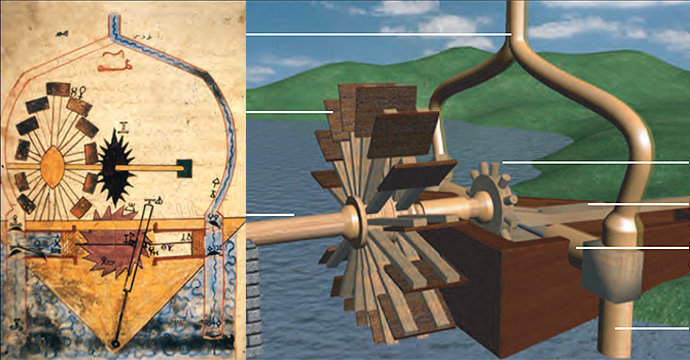
(Left) A manuscript shows Al-Jazari’s reciprocating pump. This was the first time an illustration of a crank appeared in a manuscript* – (Right) 3D animated image of reciprocating pump (Source)
Sources
Historical references and archaeological evidence concerning water-powered machines in the Greek, Roman and Islamic world are given in the works on history of technology by Forbes (1957), Schioler (1973), Oleson (1984), Hill (1984/1996; 1986), Schnitter (1994), El Faiz (2005). In his monumental work on Science and Civilisation in China J. Needham (1965 & 1966) extended the comparative study by considering Chinese evidence.
If we focus our study upon Arabic primary sources, we encounter mentioning of such machines in travel reports as well as in works of cosmography (i.e. combination of geographical data with cosmological and philosophical doctrines) describing Islamic and non-Islamic countries. Further genres are treatises on agriculture, on the rural projects of the State, and finally special treatises concerned with the description of ingenious devices, a kind of marvellous machines conceived on the basis of mechanics and hydraulics.
In the following we shall present first some typical references in Arabic geographic texts of the 10th century AD. We shall then proceed by considering a treatise of the beginning of the 11th century on hydraulic projects of the Muslim state and several texts on agricultural engineering. We shall conclude by referring to several texts concerned with imagery and visions of hydraulic technology as well as with the typical Arabic tradition of hydraulic marvellous machines.

(Left) Third page of the section devoted to the six-cylinder pump in the Chester Beatty MS (p. 38) of Al-Turuq al-Saniya. – (Right) 3D animated image of six-cylinder pump (Source)
Utilitarian perspectives
Arab geographers often refer to agricultural production of the countries they describe. A special aspect in such descriptions is the dependency of agriculture on water management. Irrigation systems, darns, as well as water-mills belong to large-scale technology which becomes a positively connoted sign of the landscapes described.
Al-Muctaddasi (d. 1000 AD) describes several dams in Iran, among which a pre-Islamic dam which provided hydraulic power in Khuzistan, and a dam built in the 10th century AD on the river Ki1r, in the Iranian province Fars, by the Buyid emir eAcIrtd al-Dawla:
 Adud al-Dawla closed the river between Shiraz and Istakhr by a great wall, strengthened with lead. And the water behind it rose and formed a lake. Upon it the two sides were ten water-wheels like those mentioned in Khuzistan, and below each wheel was a mill, and it is today one of the wonders of Fars.” (Al-Muqaddasi, Arabic text p. 344; Engl. translation quoted from Hill, 1984, p. 137)
Adud al-Dawla closed the river between Shiraz and Istakhr by a great wall, strengthened with lead. And the water behind it rose and formed a lake. Upon it the two sides were ten water-wheels like those mentioned in Khuzistan, and below each wheel was a mill, and it is today one of the wonders of Fars.” (Al-Muqaddasi, Arabic text p. 344; Engl. translation quoted from Hill, 1984, p. 137)The positive attitude of Arab and Persian writers towards water power and milling is expressed in the way they estimate water stream according its capacity in powering mills. Referring to Upper Mesopotamia, the granary of Baghdad, Ibn klawqal (10th century AD) underlines the use of Tigris stream for powering ship-mills:
 The ship-mills on the Tigris at Mosul have no equal anywhere, be-cause they are in very fast current, moored to the bank by iron chains. Each [mill] has four stones and each pair of stones grinds in the day and night 50 donkey-loads. They are made of wood —sometimes of teak.” (Ibn klawqal, Arabic text p. 219; Engl. translation quoted from Hill, 1984, p. 137)
The ship-mills on the Tigris at Mosul have no equal anywhere, be-cause they are in very fast current, moored to the bank by iron chains. Each [mill] has four stones and each pair of stones grinds in the day and night 50 donkey-loads. They are made of wood —sometimes of teak.” (Ibn klawqal, Arabic text p. 219; Engl. translation quoted from Hill, 1984, p. 137)In 1184 AD Ibn Jubayr (1145-1217 AD) describes the ship mills across the river Khabur in Upper Mesopotamia with the exalting expression “fonning, as it were, a dam” (Ibn Jubayr, Arabic text p. 243; Engl. translation quoted from Hill, 1984, p. 137).
Even tidal mills are mentioned, e.g. by al-Muqaddasi:
 The ebb-tide is also useful for operating the mills, because they are at the mouths of the rivers, and when the water comes out it turns them.” (Engl. translation quoted from Hill, 1984, p. 138)
The ebb-tide is also useful for operating the mills, because they are at the mouths of the rivers, and when the water comes out it turns them.” (Engl. translation quoted from Hill, 1984, p. 138)What is characteristic in all above references is the narrative scheme of the Arab geographers according to which the utilitarian use of water-powered rural machines appears as an indicator for improving the prosperity of the regions described (Hill, 1991, p. 184). Only few technical details of functioning or construction are mentioned, which implies that the authors had poor knowledge of or no interest in such details. Their main goal was to present these human constructions as something exceptional, as “wonders” which contributed to the image and the prestige of the regions.
A different utilitarian perspective can be traced in treatises concerned with agriculture. Already in the Nabatean Agriculture, a treatise translated from the Syriac into Arabic in the 10th century AD (El Faiz, 2005, p. 30) we get a detailed description of water-raising machines, such as sciqiya, a perpendicular potgarland driven by an animal which rotates a horizontal beam fixed to the perpendicular axis with a gearing to the potgarland. The sources we will refer to come from al-Andalus. Most probably the *rya was introduced into the Iberian Peninsula by the Arabs. In the treatises of the AndalusT agronomists Ibn al-‘Awwam and Abu l-Khayr several water-raising machines used in agriculture are not only described in their outlook and functioning but also with respect to their construction specifications and the possibilities of improving thief efficiency —perhaps a rational option of prestige writing (El Faaz, 2005, pp. 219-220; Glick, 1992, p. 981).
Patterns of prestige and political legitimacy
Prestige issues are conventionally associated to persons of the political stage (or, more generally, of the public sphere). It is, therefore, understan-dable that important works related to water —whether providing drinking water, establishing adequate irrigation of fields or constructing water-powered machines— have been honourably attributed to distinguished Muslims. A well-known example is the project to provide the pilgrimage mute from Baghdad to Mecca with drinking water. The idea was inherent to the religious duties of the Muslim caliph. It is Zubayda (d. 831 AD), one of the wives of the Abbasid caliph Harun al-Rashid (786-809 AD), who has associated her name with the project of a canal supposed to carry water from Baghdad all the way down to Mecca. The idea and some financial details of the project are mentioned in the biographical dictionary of Ibn Khallikan(1211-1282 AD) (lbn Khallikan, vol. I, p. 337). However, no precise information concerning any realised parts is provided, except of the plant for supplying Mecca with water from a spring some 25 miles away. In his journey description Ibn Jubayr (1145-1217 AD) gives some aspects of the water supply along the route from Baghdad to Mecca (El Faiz, 2005, pp. 111-114). However, this hydraulic infrastructure is commonly attributed to the caliph al-Ma’mfm (813-833 AD) (El Faiz, 2005, p. 113). The imprecise and often contradictory information about the ambitious water-supply projects concerning the Islamic Holy Place (Hitti, 1970, p. 302; El Faiz, 2005, p. 111-114) underlines the symbolic value of the subject and renders the several versions of the narrative a pattern of prestige and political legitimacy rather than a puzzle of historical evidence.
Similar narratives of political prestige and power concern prestigious regional rulers or public persons, e.g. the “superintendent of irrigation” of Mery in the 10th century, who was said to have more power than the prefect of the city since he commanded some 10000 workers to build and maintain irrigation canals and dams, and a series of 10 norias and attached mills (Ibn 1;lawqal, pp. 635-636; Hill, 1984/1996, p. 25). With reference to the same dam of the river Kur in Fars mentioned by al-Muqaddasi (al-Muqaddasi, p. 344), Ibn al-Balkhi underlines 150 years later (12th cent. AD) the labour organised and the money spent by ‘Adud al-Dawla for constructing the dam (Lambton, p. 867).
A report combining description and admiration of administrating irrigation services is included in the Kitab al-Hawi dating to the 2nd quarter of the 11th century AD (Cahen, 1949-1951, pp. 117-143). Among fiscal regulations we find detailed data concerning the output of the various water-driven plants: mills, water-raising machines, etc. Written at the end of the Buyid era it is a typical demonstration of political legitimacy through a discourse based on the hydraulic network.
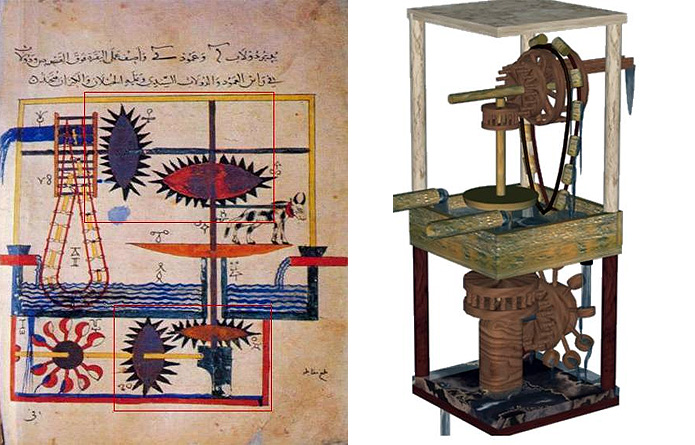
(Left) Page from a 13th-century manuscript depict a water-raising machine designed by Al-Jazari. (Source)
Hydraulic imagery and marvellous machines: cosmographies, hiyal
The Arabic reports about irrigation plants, dams and water-powered ma-chines formed a cultural construction which could be called hydraulic imagery. Quite often patterns of this imagery were associated with individual biographies. The Egyptian historian Ibn al-Qifti (1172-1248 AD) reports about the audacious project of the Basrian scientist Ibn al-Haytham (965-1039 AD) who considered to erect a dam on the river Nile near the first cataract in the south of Aswan. The aim of this vision was the effective regulation of the annual overflow of the Nile (Ibn al-Qifti, pp. 114-116). After having been officially invited by the Fatimid caliph al-Ijakim, Ibn al-Haytham surveyed the region, but apparently gave up his plan. It is reported that he then “simulated” madness in order to escape the wrath of the Fatimid caliph. It is not easy to exclude exaggerations and gigantomany with respect to the biographies of the Fatimid caliph or Ibn al-Haytham; this could be the contribution of the historiography to the formation of hydraulic imagery in the service of glorifying or colouring individuals. On the other hand the subject itself is the prototype of an incredible gigantesque project. The name of the Basrian scientist remained inherently associated with his hydraulic utopia and his “collateral madness” as embodied exaltation (El Faiz, 2005, pp. 129-137).
Exaltations in reports concerning agricultural technology, particularly hydraulic machines, as well as affinity to the Arabic literary form of the “wonders” (‘aja’ib) (Dubler, pp. 203-204; Institut du Monde arabe, 1978) are typical characteristics of textual sources on travelling and geography of the 12th to the 14th centuries AD. These aspects are especially prominent in treatises which present both geographical evidence and cosmological models explaining the data on a philosophical and theological basis. In modern terms such treatises are usually called cosmographies. This is not to say that information on prestigious and highly estimated hydraulic constructions that is provided in such treatises is generally exaggerated. Many references of technological devices constitute today valuable information on medieval technology, i.e. the mention that we find in al-Qazwini’s cosmography (1203-1283 AD) about the water-mill with horizontal wheel in Malaga. In the cosmography of al-Dimashqi (1256-1327 AD) such descriptions mostly refer to extraordinary ways of using natural resources (matter, wind or water).
In the description of the land of Azerbaijan al-Dimashqi presents the fortified town of Merend (Mehren, 1884, pp. 254-255, French translation; Mehren, 1866, p. 188, Arabic text). The information he gives about this place is concentrated on its remarkable water-mill: “In the place named Merend there is a mill which is put in rotation by a still water; and this belongs to the marvels of the world. It is built in the following way:
 The mill house comprises two stone mills with two water wheels. Each water wheel is put in rotation by its own water [stream]. The upper [mill] stone rotates and grinds the grain. The two water wheels are fixed at the lateral parts of a vault in which the water remains stored with a depth of a man’s body and a breadth as well as a length of 6 cubits [e.g. ca. 4 m]. In the middle of this vault there is a pillar stretched like a bridge [horizontally] over the breadth of the vault and fixed on both side walls. This pillar bears two reinforced leaden water pipes which hold on each other tightly [unified] and hang over the pillar up to the surface of the water. Both water pipes are open. Inside there is a structure [device?] by means of which the water is sucked up towards a height of half a cubit [e.g. ca. 34 cm]. It is elevated in it [i.e. in the pipes] and kept on in stream until it flows down powerfully through the other pipe, which rises over the surface of the water in a certain distance. Thus the water flows out from this pipe and, as it falls on the water wheel, it revolves the wheel and moves the mill stone. After falling on the wheel scoops the flowing water reaches the same water [of the storing basin], then it is raised up in the other pipe turned to the other side and flows down from there. This pipe is of the same height and breadth [as the first one]. Thus each pipe sucks alternatively the water ejected by the other, so that the water mass neither decreases nor increases nor moves except at the openings of the two pipes where they suck up and pour out again the water.”
The mill house comprises two stone mills with two water wheels. Each water wheel is put in rotation by its own water [stream]. The upper [mill] stone rotates and grinds the grain. The two water wheels are fixed at the lateral parts of a vault in which the water remains stored with a depth of a man’s body and a breadth as well as a length of 6 cubits [e.g. ca. 4 m]. In the middle of this vault there is a pillar stretched like a bridge [horizontally] over the breadth of the vault and fixed on both side walls. This pillar bears two reinforced leaden water pipes which hold on each other tightly [unified] and hang over the pillar up to the surface of the water. Both water pipes are open. Inside there is a structure [device?] by means of which the water is sucked up towards a height of half a cubit [e.g. ca. 34 cm]. It is elevated in it [i.e. in the pipes] and kept on in stream until it flows down powerfully through the other pipe, which rises over the surface of the water in a certain distance. Thus the water flows out from this pipe and, as it falls on the water wheel, it revolves the wheel and moves the mill stone. After falling on the wheel scoops the flowing water reaches the same water [of the storing basin], then it is raised up in the other pipe turned to the other side and flows down from there. This pipe is of the same height and breadth [as the first one]. Thus each pipe sucks alternatively the water ejected by the other, so that the water mass neither decreases nor increases nor moves except at the openings of the two pipes where they suck up and pour out again the water.”It is not the purpose of the present study to smooth or modernise the text in order to make it understandable as far as the functioning of the twin water-pipes is concerned. The details provided by the text are not enough to reconstruct the outline of the plant; they do not even elucidate the several possible functions. Even the illustration embedded in the manuscript and referring to the water-mill does not just illustrate the text (Canavas, 2005, pp. 291-297). Moreover, it underlines the apparent goal of the presentation of the water-mill of Merend by al-Dimashqi: the marvel described here is a perpetuum mobile. Work (i.e. turning the mill stones) is done without any visible input of external power!
The textual treatment of hydraulic machines as marvels finds its most remarkable expression in the compendia of ingenious machines (Arabic: hiyal) composed by Banu Musa in Abbasid Baghdad (9th century AD) and by al-Jazari in Diyarbakir (1206 AD). The Book of Ingenious Devices of the brothers Banu Musa contains descriptions and illustrations of 100 devices. Al-Jazari’s compedium yields descriptions and construction de-tails for 50 elaborate devices which combine mechanics, pneumatics and hydraulics (Hill 1984/1996, p. 199 ff.). Both treatises refer to design and construction for palace environments —”utilitarian” purposes similar to those of the rural machines described above are not mentioned in the biyal treatises.
Conclusions
In our study we analysed several Arabic textual sources concerning hydraulic machines. The various patterns traced are strongly related to the specific literary forms and the historical-cultural context of the texts. Whereas travellers and geographers of the 10th century AD underline utilitarian aspects and insert the hydraulic machines into the specific political and economic landscape, later historians and biographers introduce similar utility patterns as prestige criteria in assessing persons of the public sphere: dealing with hydraulic artefacts enables exalting and distinguishing (in case of failure: discrediting) individual persons. The hydraulic imagery finds a prominent position in the literary form of the “wonders” (`aja’ib), the Arabic mirabilia, and in the category of “tricky” devices in palaces and gardens.
The above patterns are expressed through specific narrative forms. As a consequence, these forms standardised the manners in which hydraulic know-how and technology are reported. Such reports were undoubtedly inspired by the practical reality; however, it would be an over-interpretation of poor reliability to assert that they depicted social and technological practice. Even if the textual sources in many cases allow the assumption of theoretical scientific insight in the period considered, this is not enough to conclude that “practical realisation of the theory” was just a question of logistics. Technology in the era considered here was not “applied science”. The social conditions of technology development might have been quite different from those of literary production, and the motives for using certain narrative forms are not to be found in the literal content of these narratives. In order to trace the paths of know-how transmission from the Nabateans up to the Muslim Arabs additional historical sources and archaeological evidence are still required.
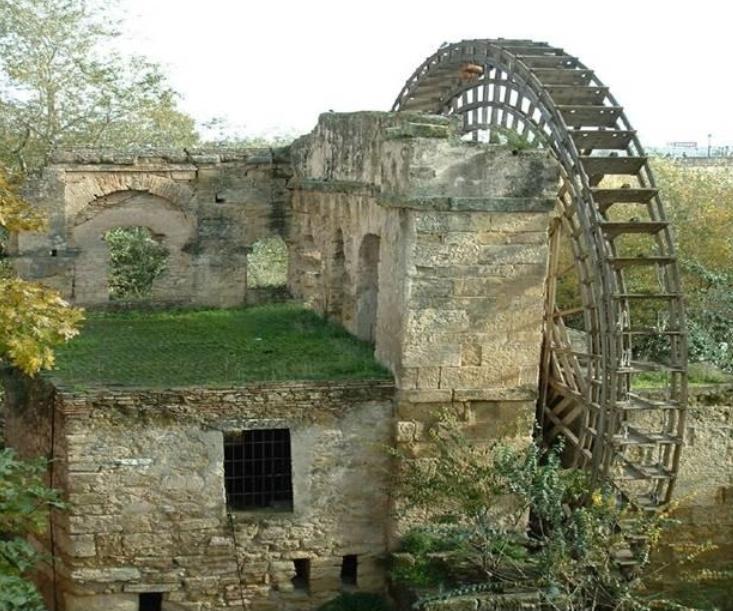
The Albolafia noria, or waterwheel, is the last vestige of an array of mills and dams built on the Guadalquivir River in Cordoba between the 8th and 10th centuries as it appears in its present condition. (Source)
References
- CAHEN, Cl., 1949-1951. “Le service de l’irrigation en Iraq au debut du XI’ siècle”. Bulletin d’etudes orientales, Damas, XIII, 117-143.
- CANAVAS, C., 2005. “Erinnerungsprozesse in der Wissensreprasentation: Raumliche Ordnungskonzepte in Illustrationen arabisch-islamischer Handschriften”, in S. Damir-Geilsdorf, A. Hartmaim and B. Hendrich (eds.), Mental Maps – Baum – Erinnentng, Münster, 285-301.
- DUBLER, C. E.: ‘aja’ib, article in Eld, I, 203-204.
- EL FAIZ, M., 2005. Les maitres de I ‘eau. Histoire de i’hydraulique arabe. Arles: Actes Sud.
- FORBES, R. J., 1957. “17. Power” & “19. Hydraulic engineering and sanitation”, in SINGER, Ch. et al (eds.): A History of Technology, Oxford: Oxford University Press, vol. II, pp. 589-622 & 663-694.
- GLICK, Th., 1992. “Hydraulic Technology in Al-Andalus”. The Legacy of Muslim Spain. Leiden: Brill, 974-988.
- HILL, D. R., 1984. “Information on Engineering in the works of Muslim Geographers”. History of Technology, London, 9, pp. 127-142.
– 1984/1996. A History of Engineering in Classical and Medieval Times. London/New York: Routledge.
– 1986. “Ma’; 2. Hydraulic machines”, in Eld, Leiden: Brill, vol. V, pp. 860-862.
– 1991. “Arabic mechanical engineering: Survey of the historical sources”. Arabic Sciences and Philosophy, 1, pp. 187-209. - HITTI, Ph. K., 1970. History of the Arabs. (10 ed.) Houndmills: Macmillan.
- IBN AL-QIFTI, 1903. Akhbar al-hukama Ed. J. Lippert, Leipzig.
- IBN HAWQAL, 1938. Kitab surat al-ard Arabic text ed. J. H. Kramers, ed. of vol. 2 of BGA. Leiden: Brill.
- IBN JUBAYR, 1907: Rihla (Journey). Ed. William Wright, 2nd ed. M. J. de Goeje, Leyden.
- IBN KHALLIKAN, 1843-1871: Wafayat al-A’yan… Cairo: 1299 a. H. (3 vols.); Engl. transl. De Slane, Paris, 4 vols,.
- Institut du Monde arabe (ed.) (1978): L’etrange et le merveilleux dans I ‘Islam medieval (Actes du colloque tenu au College de France a Paris, en mars 1974), Paris.
- LAMBTON, A. K. S. “Ma’: Irrigation of Persia”, article in Eld, V, 865-874.
- MEHREN, A. F. (Ed.), 1866. Cosmographie de ed-Dimichqui (texte arabe), Saint-Petersbourg.
- MEHREN, A. F. (Ed.), 1884. Manuel de la Cosmographie du moyen age (traduit de l’arabe), Copenhague.






















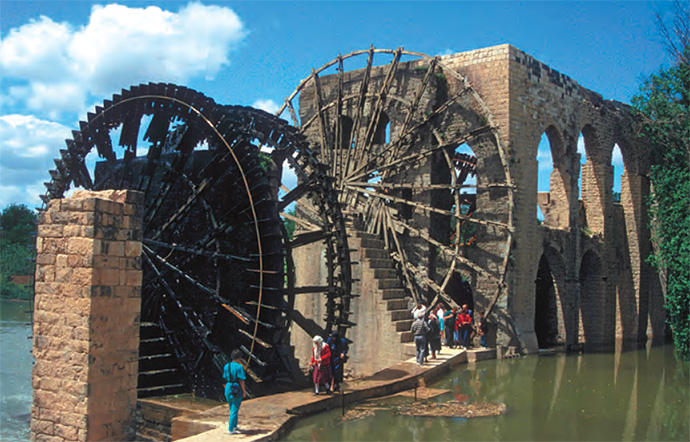
No hay comentarios:
Publicar un comentario